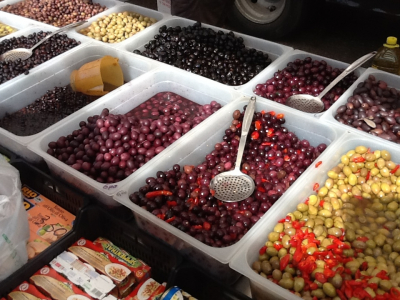The olives on the market
Many are the types of olives lining the supermarket shelves or on sale in the stands and stalls of country markets. They come in all shapes and sizes: cured, uncured, dehydrated, dried, black and so-called special olives

Italians consume large amounts of table olives, but despite this, very little money is invested in their production. We prefer to import them from abroad, and to be honest, these little savouries can be truly excellent. In one word, heavenly.
Fresh olives are very bitter, and to make them palatable, it is necessary to remove those compounds that are responsible for this unpleasant trait. This can be done by either curing the olives with lye, immersing them in a liquid bath to dilute the bitter compounds or through biological processes (fermentation).
The treated olives can be either salt-packed, preserved in brine or in a solution containing preservatives or acidifying agents, placed in modified atmosphere packets, or subjected to heating. They may also be destined to other, different preparations, branded as “special”.
Cured olives
Green, semi-ripe or ripe olives are cured with lye to remove their bitterness and placed in fermentation vessels full of brine. After partial or complete fermentation, acidifying agents can be added to the olives before placing them on the market:
– cured green olives in brine,
– cured, semi-ripe olives in brine,
– cured ripe olives.
Uncured olives
Green, semi-ripe or ripe olives are treated directly with brine, subjected to partial or complete fermentation and preserved in the presence or absence of acidifying agents:
– uncured green olives,
– uncured, semi-ripe olives,
– uncured ripe olives.
Dehydrated and/or dried olives
Green, semi-ripe or ripe olives that may be treated with a diluted lye solution to remove their bitterness are then preserved in brine or partially dehydrated by salt-packing them or subjecting them to heating or other technological processes:
– dehydrated and/or dry green olives,
– dehydrated and/or dry semi-ripe olives,
– dehydrated and/or dry ripe olives.
Oxidised black olives
Green or semi-ripe olives are placed in fermentation vessels full of brine and may undergo partial or complete fermentation. They are then blackened by oxidation in an alkaline environment before being stored in hermetically sealed, sterile tins. They have a uniform black colour.
– Black olives
There are also the so-called “special olives”, obtained through techniques other than those just described. These products can only be marketed as “olives” if the drupes employed meet the requirements set forth by law. What really matters is that the name used for these specialities is sufficiently explicit so as not to confuse the consumer as regards the origin and nature of the product.
Photo by Luigi Caricato
To comment you have to register
If you're already registered you can click here to access your account
or click here to create a new account


Comment this news